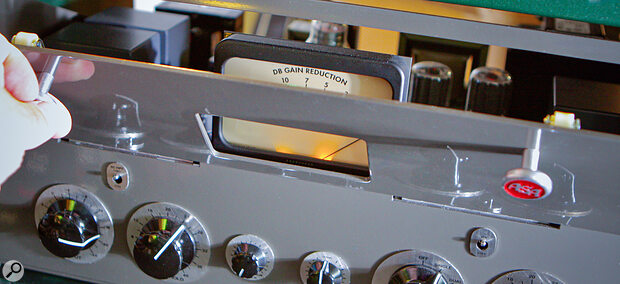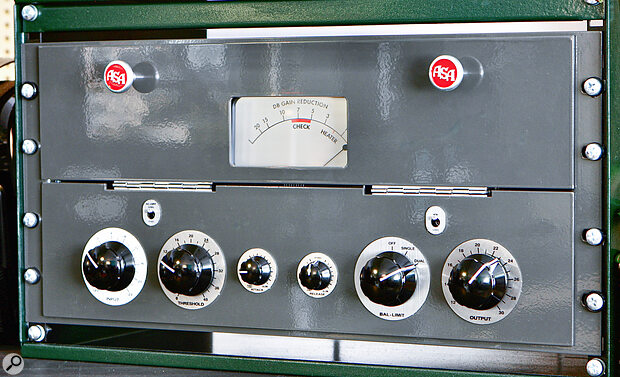AudioScape’s take on the classic RCA valve compressor is much more than just a clone...
Measuring a staggering five rack units tall, this behemoth, single‑channel valve compressor undeniably has one of the poorest height‑to‑channel‑count ratios! And with nine valves and five transformers employed in the design, the AudioScape ASA‑6A will probably not win any medals when it comes to efficiency either. So you’d hope that what might appear to be an absurdly over‑the‑top design can cast some sort of magic on your audio. Does it manage to do that? Let’s find out...
Design & Improvements
Of course, it wasn’t AudioScape’s idea to claim so much rack space! From the overall form factor, the RCA ‘umber grey’ chosen for the meticulously crafted housing, the big VU meter and both the bulky RCA‑style knobs and the two red pull‑knobs at the top, it’s pretty clear that the ASA‑6A is based on the vintage RCA BA‑6A variable‑mu compressor. Developed in the early 1950s, in that famously ‘bigger is better’ country near Greenland, the BA‑6A found use mainly in radio stations, but over time it also became highly valued in music recording studios. Today, original units are very sought after and, you guessed it, awfully pricey. Naturally, then, there’s a demand for more reasonably priced recreations.
Florida‑based AudioScape have quickly earned a reputation for building high‑quality but relatively affordable US‑made replicas of classic processors such as the UREI 1176, the Pultec EQP‑1A and the Gates Sta‑Level. It won’t be surprising to those familiar with the brand, then, that their ASA‑6A manages to remain very true to the original RCA design, to the extent that it employs NOS valves wherever available, custom‑wound transformers, carbon composition resistors and paper‑in‑oil capacitors.
Yet, AudioScape have also chosen to enhance the parameter set, to address some of the limitations of the original (for example, its fixed attack time). All of the original BA‑6A’s values remain selectable (they’re clearly labelled ‘stock’) but the number of front‑panel controls has doubled. The user can control both input and output level and separately set the compression threshold, and can independently set the attack and release times too. There’s also a switchable 120Hz side‑chain filter, as well as an attenuator that can be switched into the negative feedback (NFB) circuit, to increase both the level and harmonics. And while it’s a mono unit, the side‑chains of two ASA‑6As can be combined for stereo use. On the subject of controls, the chunky RCA‑style knobs all look great, though I did feel they might benefit from a slightly higher turning resistance. The red knobs at the top are effectively drawer‑handles: pull these, and the upper half of the front plate tilts forward to reveal all the transformers, valves, calibration pots and the power switch.
 As on the RCA BA‑6A, the upper half of the front plate tilts forward to provide easy access when rackmounted to the valves and the on/off switch.
As on the RCA BA‑6A, the upper half of the front plate tilts forward to provide easy access when rackmounted to the valves and the on/off switch.
With so many valves used, both for gain reduction and amplification, it’s good that the valve types employed in the ASA‑6A don’t, at the time of writing at least, cost a fortune to replace. This colossal compressor’s most important function is performed by one of its two 6SJ7 pentodes. It’s...
You are reading one of the locked Subscribers-only articles from our latest 5 issues.
You've read 30% of this article for FREE, so to continue reading...
- ✅ Log in - if you have a Digital Subscription you bought from SoundOnSound.com
- ⬇️ Buy & Download this Single Article in PDF format £0.83 GBP$1.49 USD
For less than the price of a coffee, buy now and immediately download to your computer, tablet or mobile. - ⬇️ ⬇️ ⬇️ Buy & Download the FULL ISSUE PDF
Our 'full SOS magazine' for smartphone/tablet/computer. More info... - 📲 Buy a DIGITAL subscription (or 📖 📲 Print + Digital sub)
Instantly unlock ALL Premium web articles! We often release online-only content.
Visit our ShopStore.

